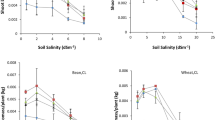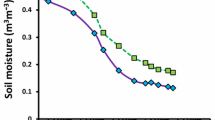Abstract
The influence of moisture and salinity of quartz sand on activation of the CO2 emission and water consumption by seeds of spring wheat (Triticum), winter rye (Secále cereále), triticale (Triticosecale), and spring barley (Hórdeum) treated by a stimulant was studied under conditions of a model experiment. It was found that the seeds treated with a stimulant get advantages in the development upon a decrease in the water content of quartz sand. However, in the case of sand salinization, stimulant application did not lead to acceleration of seed development. The deficiency of moisture in saline sand also resulted in the increase of stimulant application efficiency. It was supposed that optimum moisture contents of quartz sand for seed germination and for the development of endophytic microorganisms do not coincide: active development of endophytic microorganisms stimulating seed development began under a lower moisture in comparison with that of the active seed development. Thus, active development of endophytic microorganisms upon the low moisture content mitigates the deceleration of seed development in the case of water deficiency. Hence, application of the microbial stimulant for seeds should be efficient in the cases, when germination of seeds proceeds under conditions of possible moisture deficiency, i.e., in the regions, where early spring droughts are frequent.
Similar content being viewed by others
References
S. I. Aksenov, Role of Water in Regulation of Biological Processes (Institute of Computer Sciences, Moscow, 2004) [in Russian].
L. A. Aksenova, E. A. Zak, M. A. Bocharova, and N. L. Klyachko, “Effect of presowing treatment of wheat seeds by surfactants on their germination under unfavorable conditions,” Fiziol. Rast. 37 (5), 1007–1014 (1990).
A. M. Dmitriev and L. K. Stratskevich, Stimulation of the Plant Growth, Ed. by N. F. Batygin (Uradzhai, Minsk, 1986) [in Russian].
O. V. Isaeva, A. M. Glushakova, S. A. Garbuz, A. V. Kachalkin, and I. Yu. Chernov, “Endophytic yeast fungi in plant storage tissues,” Biol. Bull. 37, 26–34 (2010).
S. N. Kabuzenko, V. G. Blokhin, and N. I. Kopylov, “Influence of biological activity of substances on seed germination and growth of seedlings of cultured plants on saline soils,” in Regulators of the Plant Growth (Leningrad, 1989), pp. 25–29.
A. V. Kravets, D. L. Bobrovskaya, L. V. Kasimova, and A. P. Zotikova, “Presowing treatment of the seeds of spring wheat by humic preparations from peat,” Vestn. Altaisk. Gos. Univ., No. 4, 22–24 (2011).
V. V. Nemchenko and M. Yu. Tsypysheva, “Influence of biopreparations and growth regulators on the yield of spring wheat,” Vestn. Altaisk. Gos. Univ., No. 8, 5–8 (2014).
M. G. Nikolaeva, M. V. Razumova, and V. N. Gladkova, Handbook on Germination of Resting Seeds (Nauka, Leningrad, 1985) [in Russian].
N. V. Obrucheva and O. V. Antipova, “Physiology of initiation of seed germination,” Fiziol. Rast. 44 (2), 287–302 (1997).
Yu. V. Rogozhin and V. V. Rogozhin, “Technology of presowing treatment of wheat grains by solutions of inorganic and organic substances,” Vestn. Altaisk. Gos. Univ., No. 7, 11–17 (2013).
A. B. Savinov, “Autocenosis and democenosis as symbiotic systems and biological notions,” Zh. Obshch. Biol. 73 (4), 284–301 (2012).
L. K. Sechnyak, N. A. Kindruk, O. K. Slyusarenko, V. G. Ivashchenko, and E. D. Kuznetsov, Ecology of Wheat Seeds (Kolos, Moscow, 1983) [in Russian].
B. P. Stroganov, The Plants and Saline Solis (Academy of Sciences of Soviet Union, Moscow, 1958) [in Russian].
G. N. Fedotov and M. F. Fedotova, “Evaluation of the germination capacity of seeds,” in Role of Soils in Biosphere (Institute of Ecological Soil Science, Moscow State Univ., Moscow, 2015), No. 15, pp. 23–42.
G. N. Fedotov, S. A. Shoba, M. F. Fedotova, A. L. Stepanov, and R. A. Streletsky “Soil yeasts and their role in seed germination,” Eurasian Soil Sci. 50, 573–579 (2017). doi 10.1134/S1064229317050052
F. M. Shakirova, A. R. Sakhabutdinova, R. S. Ishdavletova, and O. V. Lastochkina, “Effect of pretreatment with methyl jasmonate on tolerance of wheat sprouts to salt stress,” Agrokhimiya, No. 7, 26–32 (2010).
Z. Shikhmuradov, Doctoral Dissertation in Biology (Derbent, 2014).
W. M. Al-Khateeb, K. Hameed, and R. A. Shibli, “Effect of salinity on Orobanche cernua seed germination,” Plant Pathol. J. 19 (3), 148–151 (2003).
M. M. Hassan, M. G. Osman, A. M. Fatoma, E. A. Elhadi, and A. E. Babiker, “Effect of salinity on Striga hermonthica seed germination and incidence on infested sorghum,” Curr. Res. J. Biol. Sci. 2 (3), 210–213 (2010).
M. Heydariyan, N. Basirani, M. Sharifi-Rad, I. Khmmari, and S. R. Poor, “Effect of seed priming on germination and seedling growth of the caper (Capparis spinosa) under drought stress,” Int. J. Adv. Biol. Biomed. Res. 2 (8), 2381–2389 (2014).
M. Jamil, M. Kanwal, M. M. Aslam, S. U. Khan, I. Malook, J. Tu, and S. Rehman, “Effect of plantderived smoke priming on physiological and biochemical characteristics of rice under salt stress condition,” Austral. J. Crop Sci. 8 (2), 159–170 (2014).
R. Munns and M. Tester, “Mechanisms of salinity tolerance,” Annu. Rev. Plant Biol. 59, 651–681 (2008).
M. Pessarakli, “Effects of a bio-stimulant and salinity stress on growth and quality of ryegrass (Lolium prenne L.),” Int. J. Water Res. Arid Environ. 4 (2), 97–104 (2015).
F. Shohani, A.-A. Mehrabi, R.-A. Khavarinegad, Z. Safari, and S. Kian, “The effect of gibberellic acid (GA3) on seed germination and early growth of lentil seedlings under salinity stress,” Middle-East J. Sci. Res. 19 (7), 995–1000 (2014).
Author information
Authors and Affiliations
Corresponding author
Additional information
Original Russian Text © G.N. Fedotov, S.A. Shoba, M.F. Fedotova, 2018, published in Pochvovedenie, 2018, No. 6, pp. 738–746.
Rights and permissions
About this article
Cite this article
Fedotov, G.N., Shoba, S.A. & Fedotova, M.F. Influence of Soil Moisture and Salinity on the Carbon Dioxide Emission and Water Consumption during Germination of Cereal Seeds. Eurasian Soil Sc. 51, 701–708 (2018). https://doi.org/10.1134/S1064229318060066
Received:
Published:
Issue Date:
DOI: https://doi.org/10.1134/S1064229318060066




